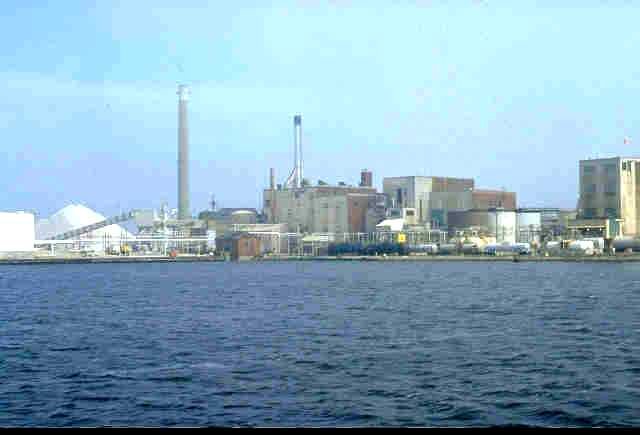Organic Chemicals, Plastics and Synthetic Fibers Effluent Guidelines

The EPA promulgated the Organic Chemicals, Plastics and Synthetic Fibers (OCPSF) Effluent Guidelines and Standards (40 CFR Part 414) in 1987, and amended the regulation in 1989, 1990, 1992 and 1993. The regulation covers wastewater discharges from more than 1,000 chemical facilities. The OCPSF Effluent Guidelines and Standards are incorporated into NPDES permits for direct dischargersA point source that discharges pollutants to waters of the United States, such as streams, lakes, or oceans., and permits or other control mechanisms for indirect dischargersA facility that discharges pollutants to a publicly owned treatment works (municipal sewage treatment plant). (refer to Pretreatment Program).
On this page:
What is OCPSF?
Facilities Covered
- 2821: Plastic Materials, Synthetic Resins, and Nonvulcanizable Elastomers
- 2823: Cellulosic Man-Made Fibers
- 2824: Synthetic Organic Fibers, Except Cellulosic
- 2865: Cyclic Crudes and Intermediates, Dyes, and Organic Pigments
- 2869: Industrial Organic Chemicals, Not Elsewhere Classified.
Note: This SIC listing is provided as a guide and does not define the coverage of the OCPSF regulations. For precise definitions of coverage, refer to the applicability sections in 40 CFR Part 414.
Subcategories
- General Requirements
- Rayon Fibers
- Other Fibers
- Thermoplastic Resins
- Thermosetting Resins
- Commodity Organic Chemicals
- Bulk Organic Chemicals
- Specialty Organic Chemicals
- Direct Discharge Point Sources That Use End-of-Pipe Biological Treatment
- Direct Discharge Point Sources That Do Not Use End-of-Pipe Biological Treatment
- Indirect Discharge Point Sources
Related Category
PFAS Advance Notice of Proposed Rulemaking
In February 2019, the EPA announced in the Per- and polyfluoroalkyl substances (PFAS) Action Plan that the Agency was taking steps to evaluate if industrial sources warranted regulation to address PFAS discharges. After studying the available data regarding wastewater discharges from facilities that manufacture PFAS, the EPA is publishing an advance notice of proposed rulemaking (ANPRM) to solicit data and information regarding manufacturers of PFAS and the presence and treatment of PFAS in discharges from this industrial category. The EPA is also requesting information regarding PFAS formulators, which are facilities that produce a variety of PFAS products and materials from PFAS feedstocks. Both PFAS manufacturers and formulators are currently regulated under the OCPSF category. The EPA will use any data and information obtained via public comment on the ANPRM to inform its decision about whether a proposed rulemaking may be necessary.
- ANPRM Federal Register Notice (March 17, 2021)
(On March 10, 2021, the EPA re-signed the Advance Notice of Proposed Rulemaking for PFAS Manufacturers and Formulators) - User Guide to the Docket for the ANPRM (March 2021)
Related Information
- PFAS Activities at EPA - Overview
- Clean Water Act Analytical Methods for PFAS - Overview
Chlorine and Chlorinated Hydrocarbon Manufacturing
Preliminary Study of Cellulose Product Manufacturing - 2011
Guidance Document
- Product and Product Group Discharges Subject to OCPSF Effluent Guidelines (2005)
Provides assistance to permit writers and regulated facilities in determining the applicability of the OCPSF regulation to various products manufactured by facilities in this category. Includes an explanation of the extensive chemical nomenclature in the regulation.
Rulemaking History
1993 Amendment
- Revised criteria for designating "metal-bearing" and "cyanide-bearing" waste streams
- Added Subpart J limitations for 19 additional pollutants (direct dischargers) and Subpart K limitations for 11 pollutants (indirect dischargers)
- Documents, including:
- Final Rule (July 9, 1993)
- Development Document - Supplement (May 1993)
1992 Amendment
- Alternative cyanide limitations for unavoidable complexing of cyanide at the process source of cyanide-bearing waste streams
- Allows control authorities to accommodate low background levels of metals in non-metal-bearing waste streams that result from the corrosion of construction materials, intake water, or other incidental metal sources
- Specifies the method of determining BOD and TSS limitations for plants that manufacture products in more than one subcategory
- Corrects listing errors in the appendices of the regulation
- Corrects subcategory listing errors for six product or product groups
- Documents, including:
- Final Rule (September 11, 1992)
1990 Amendment
- Documents, including:
- Final Rule (June 29, 1990)
1989 Amendment
- Documents, including:
- Final Rule (June 27, 1989)
1987 Rulemaking
-
Documents, including:
-
Final Rule (November 5, 1987)
-
Development Document
Describes industry processes, pollutants generated, available control and treatment technologies, the technical basis for the final rule, and costs of the rule -
Proposed Rule (March 21, 1983)
-
Additional Information
For additional information regarding OCPSF Effluent Guidelines, please contact Samantha Lewis ([email protected]) or 202-566-1058.
